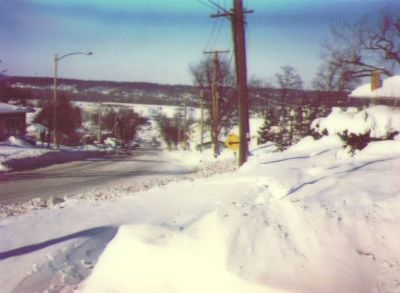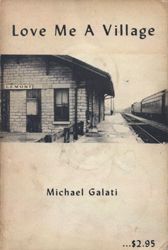
My mother, Evelyn, weeding our front yard, on State Street in Lemont, 1984
I stay pretty busy with various activities and pastimes, many of which require concentration that doesn't allow for casual daydreaming or reminiscing. But sometimes, merely for recreational purposes, I allow my mind to wander on its merry way, skipping along through the tangled forest of times that are gone.
Through a rapidly twisting series of free-associative thoughts, I recently ended up back on the subject of the place I lived for most of my childhood. When I was 9 years old, our family moved from Manhattan to Lemont, both villages in northeastern IL. It wasn't as jolting as moving from a farm to a major city, but it definitely made a similar impression on my young brain.
 My mother, Evelyn, weeding our front yard, on State Street in Lemont, 1984 |
After the gently rolling slopes and meandering streams of prime farmland, Lemont's topography on the side of the Des Plaines River valley seemed positively vertical to me. Our house perched precariously at the top of a hill overlooking the historic downtown as well as the river and I&M Canal. In the distance were the hills of the next county. Chicago was visible from the high school athletic fields, and the steeple of St. Cyril's Church was one of the highest points in Cook County. Learning to roller-skate on the sidewalk in front of our house was quite the adventure, because at the downhill end was a steep flight of stairs. We're not talking steep like Pittsburgh or San Francisco, but then at that age I'd never experienced those places.
In Manhattan, I rode the bus to school, as we lived a couple of miles outside the main town. We were within walking distance of everything in Lemont. The grade school was only a few blocks away, but it was almost like traveling to another town. My route took me along some sidewalks and across a road to a dead end street. There I walked between large limestone pillars and past old wooden bleachers overlooking a steep drop off to a wide athletic field on the flat bottom of a huge hollow. Rickety wooden stairs led down to the grassy plane and, on the other side, a long stone walkway with stairs climbed up the hill to the back of the school. There was no grass next to the school, just a lot of blacktop which sloped so much that I actually had dreams in which it seemed to roll like ocean waves.
The crater-like depression in the landscape, through which I often walked twice a day, was known (creatively) as "The Bowl." Most of the steeply sloped sides were covered in trees and weeds. A bit up one of the gentler sloping areas was an old limestone bandstand, an octagonal edifice complete with eight stone pillars that probably once held up a roof of some kind. A dramatically wide staircase led up to the flat concrete surface, and beneath it were rooms reminiscent of an old barn but with stone walls instead of wood. We could enter these spaces through the open windows, but there was nothing in there. We called the place The Castle.
 The same view after a heavy snow in 1989 |
Next to The Castle, a wide swath of grass with forest on either side led up the long hill to one of the highest points in town, the site of St. Cyril's Catholic Church. During the winter, this hill was a heck of a good sledding area, but it was exhausting to climb all the way to the top. The entire Bowl area was sort of strange, with the stonework seeming to have come from the Middle Ages, the wild areas surrounding it, and, next to a baseball diamond, two crude concrete dugouts that looked more like bomb shelters than sports facilities. I think they were painted a dismal shade of dark green. We could climb up on the roof of one because it backed into the slope. A drainage canal ran through the woods at one end of the Bowl, then went underground in a tunnel below the field and emerged at the far end to continue through the neighborhood beyond. I considered exploring the tunnel on numerous occasions, but never had the nerve to enter that dark and creepy passageway.
Much of the storm drainage for Lemont consisted of very large stone-lined canals and tunnels. During warm summer nights, a walk through the hilly streets would be punctuated by sudden gusts of chilled air, as if walking past caves. And the stones themselves were a major feature of the village. Lemont was known for its high quality limestone quarries. The familiar tan rocks seemed to be part of the basic structure of the whole place, and Lemont limestone was used for many of the buildings in the center of town. The Chicago Water Tower, built in the 1860s of this same stone, was one of the few buildings to survive the Great Fire of 1871.
The motto of our town was "Village of Faith." I remember being told that it had to do with the numerous churches, often jokingly pointed out to be on every corner across from the equally numerous taverns. When we first moved to Lemont, I was quite disturbed by the proliferation of churches, as I associated those tall, imposingly spiked buildings with dark rituals and sinister plots (as I'd seen too many horror movies). Even the grade school looked sort of church-like and, for a brief time, I had the frightening impression that my parents had enrolled me in a Catholic school. Thank goodness, THAT didn't turn out to be true. Whew!
 The Lemont Township High School yearbook when I graduated, in 1976 |
Now, when I take the occasional time trip back to my formative years, I have the aid of the internet to fill in gaps of memory or otherwise. There are some things I was well aware of when I was a kid, such as our local nuclear reactor, Argonne National Lab. The site chosen for the Manhattan Project's Chicago Pile 1, after it was deemed too dangerous to be left in downtown Chicago under the bleachers of an athletic field, was a forested area called Red Gate Woods near Lemont. We sometimes visited that site of the old reactor but there was not much to see except Quonset huts and numerous piles of strange round pellet ash. Once the new reactor (Chicago Pile 3) was built at the present site in Lemont, Argonne became the leading research facility that it remains today. My mother worked there until she retired in 1992.
But there are other aspects of Lemont's history that I have only just discovered. Somehow, my history teachers in school had a penchant for emphasizing dull and forgettable events while ignoring some real gems. Or maybe I just happened to sleep through that part of class. We did learn about the quarry worker riots, but I only recently found out that Lincoln's funeral train passed through our village on its way to Springfield. I knew of the I&M Canal's historic importance, but not that the first settlement, in the 1830s, was called Keepataw. That explains why our canoe club was called Keepataw Kanoe & Kayak Klub. Sometime around 1840 the name was Athens, a moniker also applied to the stone from the quarries, with Lemont finally taking hold around 1850. The village was incorporated in 1873, which probably accounts for why I vaguely remember celebrating our centennial in 1973.
 A book of poetry published in 1976; the cover features the Lemont train station. |
As a place to grow up, Lemont was good enough. The heavy industry along the I&M Canal meant that our air wasn't the cleanest, the river often had iridescent patches of oil floating on it, and I can distinctly remember the day of the chlorine gas leak fog and the time a refinery oil tank exploded, shaking everything along the valley. The schools were not particularly good, but I didn't have to do much to pass my classes and so had plenty of time for my other interests. The band program was engaging, and I enjoyed a small circle of friends. We were surrounded by the Cook County Forest Preserve District, so there were all manner of places to hike, hunt mushrooms, fish, and go sledding and ice skating. The proximity to bigger cities like Chicago and Joliet meant that we had access to good libraries, first-rate concerts, museums, and other cultural options not available at home.
A glance at current statistics about Lemont shows that it has grown quite a bit since I left and now has over 16,000 residents. Google Earth shows buildings erected where there were once fields and forests, and the high school covers much of what used to be the open land around it. There is very little information about what happened to the 125 or so people in my graduating class of 1976, so all I know about them is what is in a yearbook with a loose cover that my sister, who worked in the school library, rescued from the trash. At the time, I hadn't thought it was worth the money to buy my own copy, but now I really appreciate that informative relic of my gradually but consistently dimming past. I also have a little paperback book that was published in that same bicentennial year. It is a collection of poetry by one of the high school English teachers, Michael Galati, called Love Me a Village. I never felt any great attraction to Lemont, such as he describes in his poems and essays, but I knew it, was a part of it, and that makes it rather special to me.
It's a well-known aphorism that you can't go home again. I've often thought it means that time progresses in just one direction and all creatures live by that simple tenet. But in another sense, home is an ever-evolving circumstance that changes throughout our lives. Home inevitably means different things to a toddler, teenager, or middle-aged worker. For about a dozen years, as I made the transition from child to adulthood, my home was an interesting village just south of Chicago. Some of it no longer physically exists in the way that I knew it: buildings have come and gone and been transformed, springs and gullies have been filled in, trees have grown and been cut down, and everything has aged. The space is now occupied by a whole different cast of characters, and there is scant record of my brief time there. But the suite of experiences that I can still recollect gives me a pleasant sense of the past, and how it affects me now, here in the present. I don't want to go back, but I like to remember it.